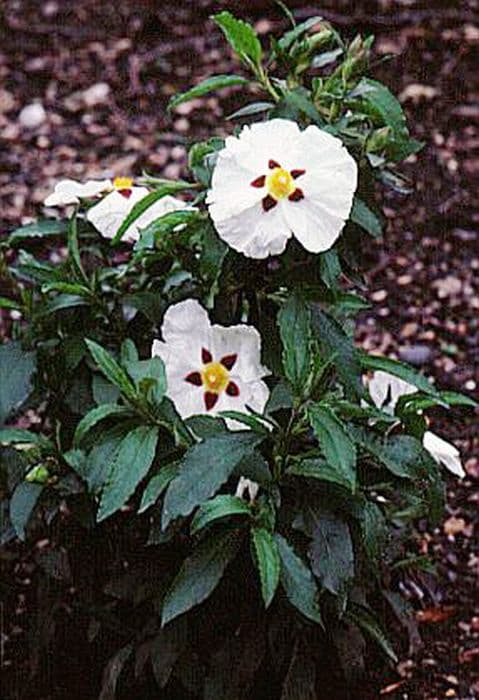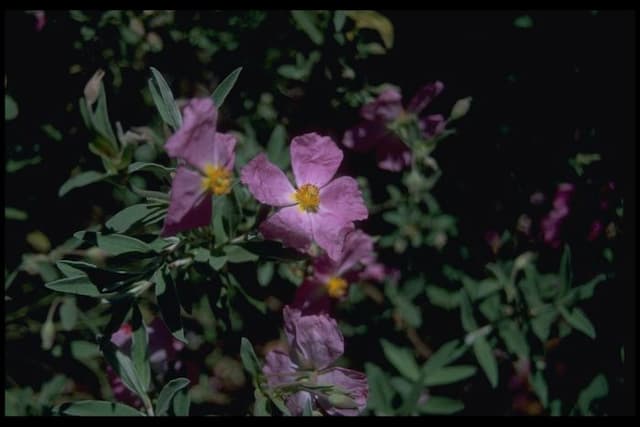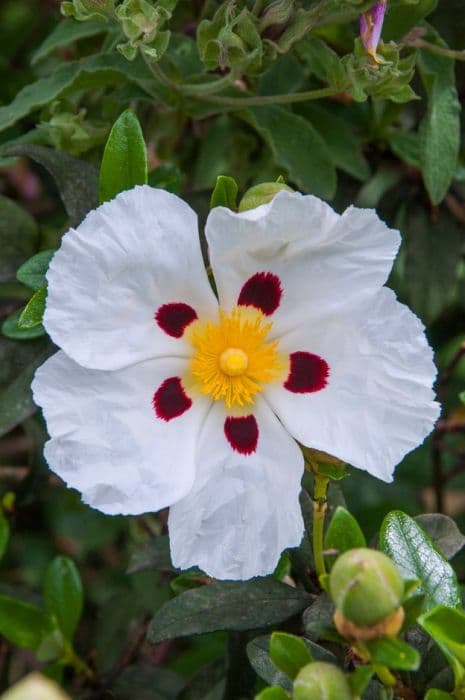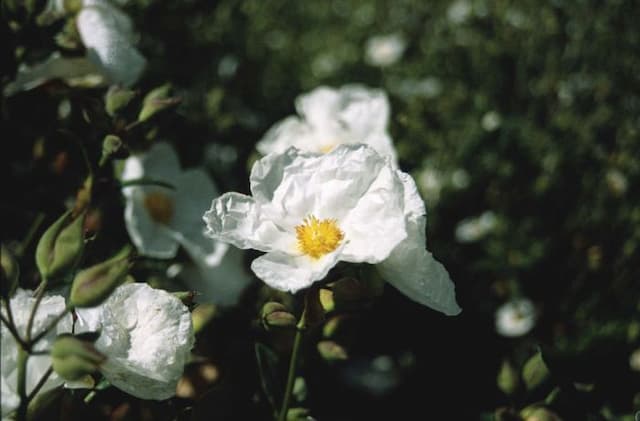Rock Rose Helianthemum 'Fire Dragon'

ABOUT
The Helianthemum 'Fire Dragon', commonly known as Rock Rose, is a colorful and eye-catching plant that boasts vibrant blooms in fiery shades of red and orange. The flowers have a distinct, saucer-like shape, and the petals have a delicate, almost paper-thin quality. In the center of each bloom, a cluster of golden stamens adds a touch of bright contrast, drawing the eye and providing a feast for visiting pollinators. The foliage of the Rock Rose is equally attractive, with small, oblong leaves that are often a silvery-green or grayish-green color, creating a soft, muted backdrop that allows the vivid flowers to stand out even more. The plant typically exhibits a sprawling habit, with branches that spread out gracefully, giving it a casual and naturalistic look that is well suited to rock gardens or sunny, dry borders.
About this plant
 Names
NamesFamily
Cistaceae
Synonyms
Rock Rose, Sunrose
Common names
Helianthemum 'Fire Dragon'.
 Toxicity
ToxicityTo humans
The Helianthemum 'Fire Dragon', commonly known as Rock Rose, is not known to be toxic to humans. Ingesting parts of this plant is not expected to cause poisoning or serious consequences under normal circumstances. As with any plant, individual sensitivities can vary, and it is generally advisable not to consume plant material that is not confirmed to be edible.
To pets
The Rock Rose is not known to be toxic to pets such as dogs and cats. If a pet ingests parts of this plant, it is unlikely to suffer from poisoning. As with all non-food plants, ingestion can sometimes lead to mild gastrointestinal upset due to the non-digestible fibers or individual sensitivities, but serious toxicity is not expected.
 Characteristics
CharacteristicsLife cycle
Perennials
Foliage type
Evergreen
Color of leaves
Green
Flower color
Orange
Height
1 foot (0.3 meters)
Spread
2 feet (0.6 meters)
Plant type
Shrub
Hardiness zones
5
Native area
Mediterranean
Benefits
 General Benefits
General Benefits- Attracts Pollinators: The bright flowers of the Rock Rose attract bees, butterflies, and other beneficial insects, promoting pollination in your garden.
- Drought Tolerance: Well-suited for xeriscaping, Rock Rose is able to thrive in dry conditions once established, making it ideal for water-wise landscapes.
- Low Maintenance: Rock Rose requires minimal care, with occasional pruning to maintain shape and encourage blooming.
- Fast Growing: This plant quickly reaches its full size, providing a rapid display of color after planting.
- Deer Resistant: Rock Rose is generally resistant to deer, making it a good choice for gardens where deer browsing is a concern.
- Ground Cover: Its low-growing habit makes it excellent for ground cover, suppressing weeds and preventing soil erosion.
- Evergreen Foliage: Rock Rose provides year-round interest with its evergreen leaves, adding continuous color and texture to the garden.
- Colorful Blooms: With vibrant red flowers, Rock Rose adds a splash of color to a garden palette, especially during the flowering season.
- Rock Gardens: This plant is well-suited for rock gardens, fitting into crevices and over rocks, enhancing the naturalistic landscape design.
- Container Gardening: Also suitable for pots and containers, Rock Rose is versatile and can decorate balconies, patios, or terraces as a potted plant.
 Medical Properties
Medical PropertiesThis plant is not used for medical purposes.
 Air-purifying Qualities
Air-purifying QualitiesThis plant is not specifically known for air purifying qualities.
 Other Uses
Other Uses- Dye Production: The vibrant flowers of the Rock Rose can be used to produce natural dyes for textiles, imparting hues ranging from yellow to orange based on the processing method.
- Photography Backdrop: Gardeners and photographers sometimes plant Rock Rose en masse to create a stunning, fiery backdrop for outdoor photo shoots.
- Craft Projects: Dried Rock Rose flowers can be used in crafting, such as making decorative wreaths, pressed flower art, or in potpourri mixes.
- Erosion Control: Rock Rose plants are effective at stabilizing loose soil and preventing erosion on sloped gardens and landscapes due to their rooting habits.
- Education and Research: The Rock Rose serves as a valuable specimen for educational purposes in botany classes or research on drought-resistant plants.
- Culinary Decoration: Though not commonly consumed, the flowers can be used as a decorative, edible garnish for salads and desserts, provided they haven't been treated with pesticides.
- Artistic Inspriation: Artists may use the Rock Rose as a muse or subject in their paintings, drawings, or photography, capturing the essence of its fiery blooms.
- Theatrical Settings: These plants can be integrated into theater productions or film set designs where a Mediterranean or dry landscape is needed to set the scene.
- Bee and Butterfly Garden: Rock Rose is an excellent choice for a pollinator garden, attracting bees, butterflies, and other beneficial insects.
- Thermal Insulation: Dense plantings of Rock Rose can provide a modest insulating effect in a garden, protecting nearby less hardy plants from temperature fluctuations.
Interesting Facts
 Feng Shui
Feng ShuiThe Rock Rose is not used in Feng Shui practice.
 Zodiac Sign Compitability
Zodiac Sign CompitabilityThe Rock Rose is not used in astrology practice.
 Plant Symbolism
Plant Symbolism- Resilience: The name 'Fire Dragon' suggests a plant that can endure and thrive in harsh conditions, embodying the quality of resilience.
- Passion: Fire is often associated with strong emotions, and a 'Fire Dragon' might be symbolic of intense passion or enthusiasm.
- Energy: The vibrant and fiery colors of the Helianthemum 'Fire Dragon' are symbolic of high energy and vitality.
- Transformation: Dragons are mythical creatures associated with change and transformation, which can be symbolized by the plant's changing appearance through the seasons.
- Warmth: With its warm hues, the Helianthemum 'Fire Dragon' can symbolize a sense of warmth and comfort.
- Radiance: The name Helianthemum comes from Greek words 'helios' meaning sun and 'anthemon' meaning flower, symbolizing the radiant and bright nature of the plant that is akin to the sun.
 Water
WaterRock roses, such as the 'Fire Dragon' variety, prefer dry to medium moisture conditions and should be watered sparingly once established. During the first growing season, water them thoroughly to establish an extensive root system, giving them about a gallon of water weekly. Once established, they are drought tolerant and may need water only during prolonged dry spells or extreme heat, roughly every two to three weeks. Avoid overwatering, as rock roses are adapted to thrive in drier conditions and can be susceptible to root rot in overly wet soil.
 Light
LightRock roses, including the 'Fire Dragon,' perform best in full sunlight where they can receive at least six to eight hours of direct sun daily. Plant them in a spot where they can enjoy the morning or afternoon sun to promote the best flowering potential and healthy growth. They adapt well to the bright, sunny spots in rock gardens or sunny borders where they can soak up the rays.
 Temperature
TemperatureRock roses like 'Fire Dragon' are hardy plants, tolerating a wide range of temperatures but favoring warmer conditions. They can typically survive minimum temperatures down to about 10 degrees Fahrenheit but thrive in temperatures between 60 and 80 degrees Fahrenheit. Plant them in areas where the temperature remains within this range for the best growth and flowering results.
 Pruning
PruningPrune rock roses like 'Fire Dragon' in early spring to maintain their shape and encourage bushiness. Immediately after blooming, light pruning can also be done to remove spent flowers and any dead or damaged wood. Annual pruning helps stimulate new growth, which improves flowering, and it's best to do this when the plant is not in active bloom.
 Cleaning
CleaningAs needed
 Soil
SoilRock Rose 'Fire Dragon' thrives in well-draining soil with a mix of loam, sand, and peat, which replicates its natural habitat. A slightly acidic to neutral pH of 6.0 to 7.5 is ideal for this plant.
 Repotting
RepottingRock Rose 'Fire Dragon' does not require frequent repotting and can be done every 2-3 years or when it outgrows its current pot.
 Humidity & Misting
Humidity & MistingRock Rose 'Fire Dragon' prefers a dry to moderate humidity level, typical of its Mediterranean origin, and does not thrive in highly humid environments.
 Suitable locations
Suitable locationsIndoor
Ensure bright light, minimal water, and well-draining soil.
Outdoor
Plant in sunny spot, well-draining soil, water sparingly.
Hardiness zone
5-9 USDA
 Life cycle
Life cycleThe life of the Rock Rose 'Fire Dragon' starts with seed germination, which requires a well-draining soil mix and warm temperatures. Once germinated, the seedling stage involves establishing a root system and producing its first sets of true leaves. As it enters the vegetative stage, the Rock Rose 'Fire Dragon' grows rapidly, developing a bushy structure with gray-green foliage. The flowering stage occurs in late spring to early summer, showcasing vibrant, orange-red flowers that attract pollinators. After pollination, the plant produces small, dry fruits containing seeds, which can fall to the ground and propagate new plants. Finally, in the dormant stage during winter, the plant's aboveground growth may die back, particularly in colder climates, but its roots typically remain alive to regenerate in the spring.
 Propogation
PropogationPropogation time
Spring-Early Summer
Helianthemum 'Fire Dragon', commonly referred to as Rock Rose, is generally propagated through cuttings. The best time to take cuttings for propagation is late spring through early summer when the plant is actively growing. Semi-ripe cuttings about 3 to 5 inches long are ideal. To propagate, select healthy, non-flowering stems and cut them just below a node. Remove the lower leaves and dip the cut end in rooting hormone powder to encourage root growth. Then, insert the cutting into a pot filled with a mix of potting soil and sand or perlite to ensure good drainage. Keep the soil moist and place the pot in a bright area with indirect sunlight. Roots will usually develop within a few weeks, after which the new plants can be potted up individually.









